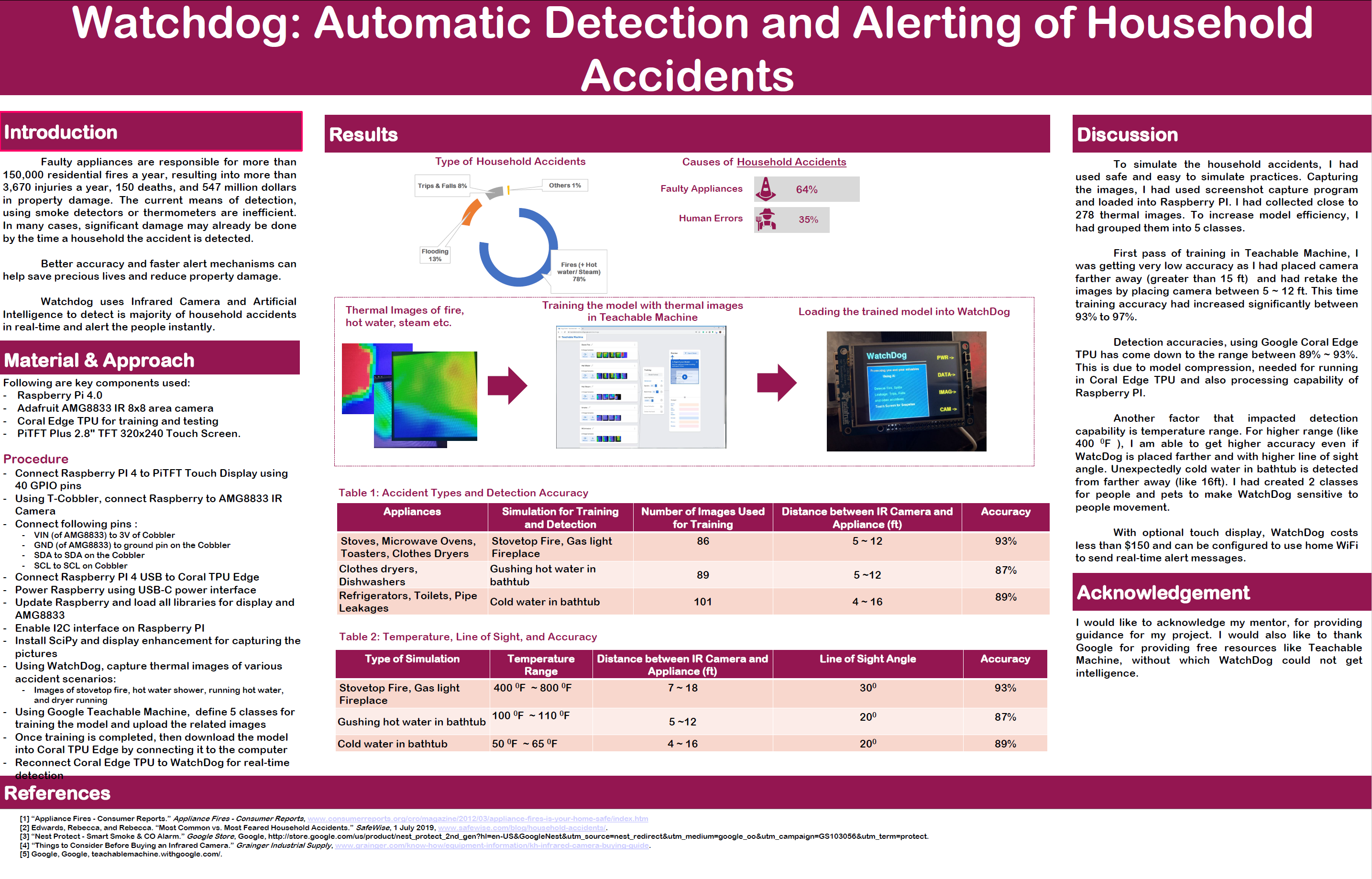Watchdog: Automatic Detection and Alerting System for Household Accidents using AI
Event: Junior Division
Category: General Science (Junior)
Student: Agasthya Gangavarapu
Table: 120
Experimentation location: Home
Regulated Research (Form 1c): No
Project continuation (Form 7): No
Abstract:
The majority of household accidents happen due to malfunctioning of appliances such as dishwashers, ovens, blenders, etc. All of the traditional detection approaches are ineffective leads to damage to the property and hurts pets and humans. I had built a smart camera enabled with a deep learning model for accurate and real-time prediction of accidents before they cause extensive damage. Using Google Coral Edge devices, Raspberry PI, AMG Thermal Camera, and a touch monitor, I had built Watchdog which can be deployed in all rooms of the house cost-effectively. I had trained the model with more than 160 images belonging to 12 types of household accidents ranging from hot water flooding to stove catching fire. The model is able to detect all 12 types with more than 90% accuracy.Bibliography/Citations:
No additional citationsAdditional Project Information
Project website: -- No project website --
Presentation files: -- No files provided --
Research paper:
Additional Resources: -- No resources provided --
Project files: -- No files provided --
Research Plan:
How to avoid domestic accidents due to malfunctioning of the household appliances like Dishwashers, Ovens, etc.?
Faulty appliances cause more than 12,000 fires and injure more than 4000 people a year in the US and most of the traditional alarming systems are ineffective in reducing the damage done to the household. We need a smart system that generates alarms sooner than later. These systems should detect any accidents or fires or smoke as soon as it happens.
My goal / expected outcomes for the project as follows:
- A smart system should detect when the malfunctioning of the appliances happen
- It should alert the people in the house and the nearest fire department as soon as it detects the malfunctioning and resulting damage such as fire, burning, flooding, or leakage
- People should be able to see and assess the damage
Hypothesis
- Most of the household accidents can be identified using thermal cameras based on thermograms generated.
- If the thermograms are annotated, then the thermograms can be used to train Deep Learning model for automatic detection of household accidents.
Detailed Procedure:
- Build a cost-effective thermal camera using Adafruit AMG8833, Raspberry PI, and TFT display for displaying the images.
- Capture a minimum of 10 images of fires with different ranges and temperatures using candles, stoves, ovens, and others. Similarly, capture a minimum of 10 images of shower fumes and hot water dropping into water tub.
- Label each of the images and feed them into Image Classification at Teachable Machines from Google. Provide names of each of the accidents as classes and train with all the labeled images.
- Take the trained image and validate for accuracy. Accuracy should exceed 90% for reliable predictions.
- Download the trained model and copy the trained model into Google Coral for speedy predictions.
- Connect Google Coral to Camera for predictions in real-time
References:
- https://www.flir.com/products/flir-one-pro/https://www.flir.com/products/flir-one-pro/
- https://en.wikipedia.org/wiki/Thermographic_camera
- https://www.howtogeek.com/294076/how-does-thermal-imaging-work/
- https://towardsdatascience.com/detecting-people-with-a-raspberrypi-a-thermal-camera-and-machine-learning-376d3bbcd45c
- https://en.wikipedia.org/wiki/Infrared_spectroscopy

